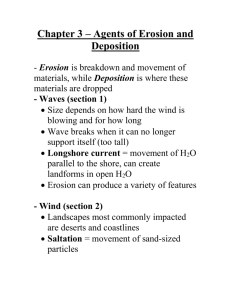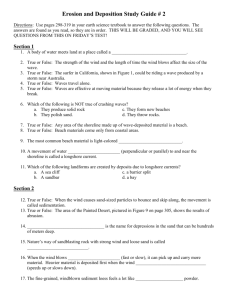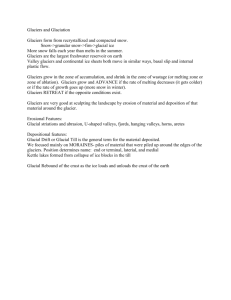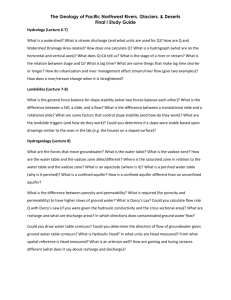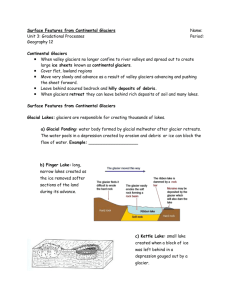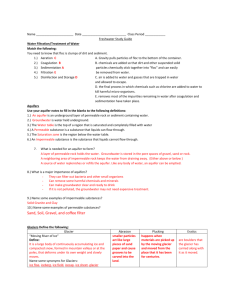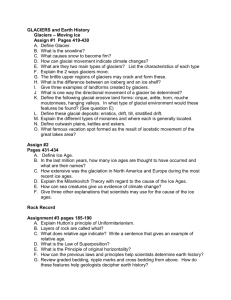DOC
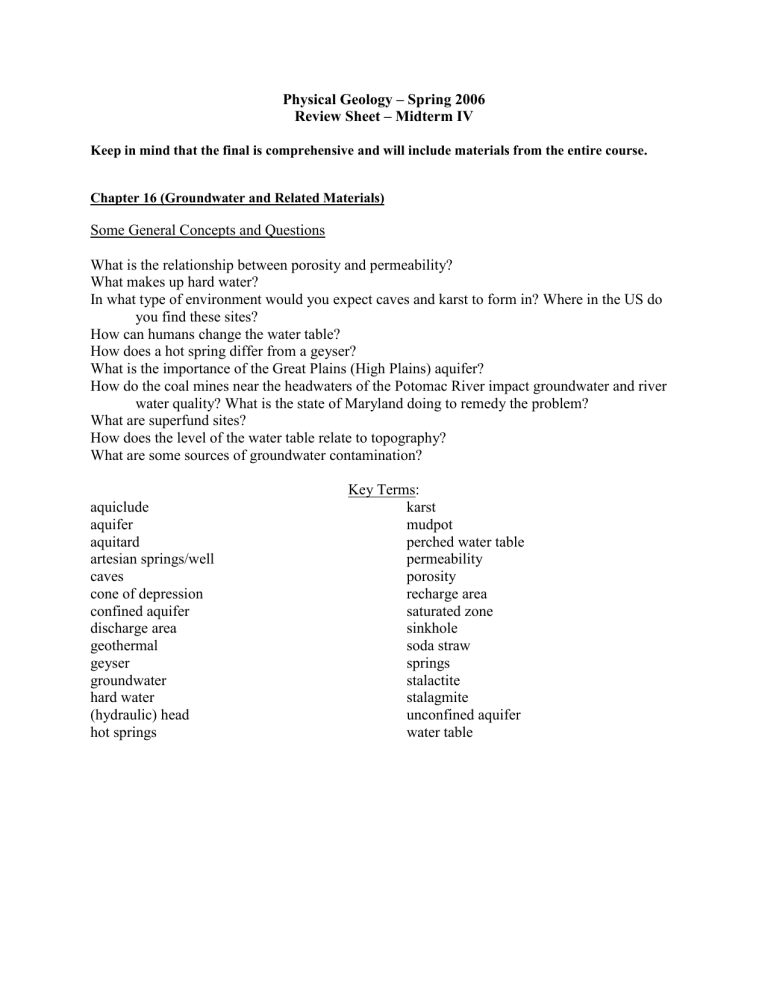
Physical Geology – Spring 2006
Review Sheet – Midterm IV
Keep in mind that the final is comprehensive and will include materials from the entire course.
Chapter 16 (Groundwater and Related Materials)
Some General Concepts and Questions
What is the relationship between porosity and permeability?
What makes up hard water?
In what type of environment would you expect caves and karst to form in? Where in the US do you find these sites?
How can humans change the water table?
How does a hot spring differ from a geyser?
What is the importance of the Great Plains (High Plains) aquifer?
How do the coal mines near the headwaters of the Potomac River impact groundwater and river water quality? What is the state of Maryland doing to remedy the problem?
What are superfund sites?
How does the level of the water table relate to topography?
What are some sources of groundwater contamination?
Key Terms: aquiclude aquifer aquitard artesian springs/well caves karst mudpot perched water table permeability porosity cone of depression confined aquifer discharge area geothermal geyser groundwater hard water
(hydraulic) head hot springs recharge area saturated zone sinkhole soda straw springs stalactite stalagmite unconfined aquifer water table
Chapter 15 (Oceans and Coasts)
Some General Concepts and Questions
What are the primary dissolved elements in the ocean?
What causes waves? Tides?
What role does bay geometry have on tides? Where are the biggest tides on Earth?
How do surface currents differ from deep currents in the oceans?
What is the geometry of particle motion in waves?
What are the controls on coastal sediment budgets? Erosion?
What are some of the controls on changes in sea level?
How does an atoll form?
What is the salinity in ocean derived from?
Amplitude
Atoll
Barrier island
Barrier reef
Bathymetry
Beach
Beach erosion
Breaker
Coasts
Key Terms
Fringing reef
Groins
Jetties
Longshore current
Longshore drift
Neap Tides
Rip Currents
Sea stacks
Spring Tides
Continental rise
Emergent coastline
Estuary
Fjord
Submergent coastline
Thermohaline Convection
Tides
Chapter 18 (Glaciers and Ice Ages)
Some General Concepts and Questions
What are the components of the Milankovitch cycles? What is their frequency?
How many ice ages existed in Earth’s history? What evidence do we have about their frequency?
How do features generated by stream erosion differ from glacial erosion?
Who is the father of glaciology?
Where do you find glaciers in the continental US?
What occurs when snow transforms into ice?
Why is it important to classify glaciers based on climate?
Is the presence of glaciers limited to high latitudes?
Where are continental glaciers found?
How do glaciers move? At what speeds?
What controls whether a glacier advances or retreats?
How can glacial till be used to infer information about past ice ages?
How do geomorphic features related to glacial events compare to features carved by moving water?
Why is the search for meteorites centered around Antarctica?
What is a glacier?
Abrasion
Albedo
Arête
Basal sliding
Brittle-plastic transition
Calving
Channeled scablands
Continental glaciers (ice sheets)
Cirques
Crevasses
Dropstones
Drumlin
Key Terms
Icebergs
Ice shelf
Internal flow
Kettles
Loess
Moraine (lateral, terminal, basal, end)
Mountain (alpine) glaciers
Plucking
Polar glaciers
Rock flour
Striations
Sublimation
Erratics
Esker
Firn
Glacial Lake Missoula
Hanging Valleys
Horns
Surges tarn
Temperate (wet bottom) glaciers
Till
Zone of accumulation
Zone of ablation
Chapter 19 (Global Change)
Some General Concepts and Questions
What isotopic system is useful in giving information about temperature in old geologic systems?
And how does it work?
What is Jack Hills and what does it have to do with global change and ideas about the early history of the Earth?
What are the oldest rocks or minerals on Earth? How do we know?
What is the relationship between changes in plate configurations and changes in climate?
Is ozone good or bad?
What are some examples of greenhouse gases?
How does the concentration of CO2 vary in geologic time?
What is the magnitude of the change in temperature at the Earth’s surface over the past century?
What problems exist in measuring temperature to get an accurate assessment of changes over time?
What are the components of the Snowball Earth Hypothesis?
Key Terms
Anthropogenic
Catastrophic Changes
Cyclic Changes
Earth system
Ozone
Snowball Earth
Supercontinent cycle
Unidirectional Changes
Gradual Changes
